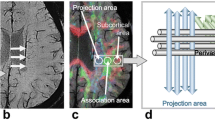Abstract
Background
Diagnosis of brainstem lesions in children based on magnetic resonance imaging alone is a challenging problem. Magnetic resonance spectroscopy (MRS) is a noninvasive technique for spatial characterization of biochemical markers in tissues and gives information regarding cell membrane proliferation, neuronal damage, and energy metabolism.
Methods
We measured the concentrations of biochemical markers in five children with brainstem lesions and evaluated their potential diagnostic significance. Images and spectra were acquired on a 1.5-T imager. The concentrations of N-acetylaspartate, tetramethylamines (e.g., choline), creatine, phosphocreatine, lactate, and lipids were measured within lesions located at the brainstem using Point-resolved spectroscopy sequences.
Results
Diagnosis based on localized proton spectroscopy included brainstem glioma, brainstem encephalitis, demyelination, dysmyelination secondary to neurofibromatosis type 1 (NF 1), and possible infection or radiation necrosis. In all but one patient, diagnosis was confirmed by biopsy or by clinical follow-up.
Conclusions
This small sample of patients suggests that MRS is important in the differential diagnosis between proliferative and nonproliferative lesions in patients without neurofibromatosis. Unfortunately, in cases of NF 1, MRS can have a rather misdiagnosis role.





Similar content being viewed by others
References
Barkovich AJ (2005) Pediatric neuroimaging, 4th edn. Lippincott-Raven, Philadelphia, pp 321–347
Biousse V, Newman NJ, Hunter SB et al (2003) Diffusion weighted imaging in radiation necrosis. J Neurol Neurosurg Psychiatry 74:382–384
Bizzi A, Ulug AM, Crawford TO et al (2001) Quantitative proton MR spectroscopic imaging in acute disseminated encephalomyelitis. AJNR Am J Neuroradiol 22:1125–1130
Castillo M, Green C, Kwock L et al (1995) Proton MR spectroscopy in patients with neurofibromatosis type 1: evaluation of hamartomas and clinical correlation. AJNR 16:141–147
Curless RG, Bowen BC, Pattany PM et al (2002) Magnetic resonance spectroscopy in childhood brainstem tumors. Pediatr Neurol 26(5):374–378
De Stefano N, Matthews PM, Arnold DL (1995) Reversible decreases in N-acetylaspartate after acute brain injury. Magn Reson Med 34:721–727
Fulham MJ, Bizzi A, Dietz MJ et al (1992) Mapping the brain tumor metabolites with proton MR spectroscopic imaging: clinical relevance. Radiology 185:675–686
Jones AP, Gunawardena WJ, Coutinho CM (2001) 1H MR spectroscopy evidence for the varied nature of asymptomatic focal brain lesions in neufibromatosis type 1. Neuroradiology 43(1):62–67
Kimura T, Sako K, Tanaka K et al (2001) In vivo single-voxel proton MR spectroscopy in brain lesions with ring-like enhancement. NMR Biomed 14:339–349
Kriger MD, Blüml S, McComb JG (2003) Magnetic resonance spectroscopy of atypical diffuse pontine masses. Neurosurg Focus 15(1):E5
Laprie A, Pirzkall A, Haas-Kogan DA et al (2005) Longitudinal multivoxel MR spectroscopy study of pediatric diffuse brainstem gliomas treated with radiotherapy. Int J Oncol Biol Phys 62(1):20–31
Möller-Hartmann W, Herminghaus S, Krings T et al (2002) Clinical application of proton magnetic resonance spectroscopy in the diagnosis of intracranial mass lesions. Neuroradiology 44:371–381
Nafe R, Herminghaus S, Raab P et al (2003) Preoperative proton-MR spectroscopy of gliomas-correlation with quantitative nuclear morphology in surgical specimen. J Neurooncol 63:233–245
Naressi A, Couturier C, Devos JM et al (2001) Java-based graphical user interface for the MRUI quantitation package. MAGMA 12:141–152
Park SH, Chang KH, Song IC et al (2000) Diffusion-weighted MRI in cystic or necrotic intracranial lesions. Neuroradiology 42:716–721
Tan HM, Chan LL, Chuah KL et al (2004) Monophasic, solitary tumefactive demyelinating lesion: neuroimaging features and neuropathological diagnosis. Br J Radiol 77(914):153–156
Thiel T, Capone A, Schneider JF et al (2000) N-acetyl-aspartate: a market for viable neurons? [abstract]. In: Book of International Society for Magnetic Resonance in Medicine’s (ISMRM’s) 8th Scientific Meeting and Exhibition. Denver, CO, ISMRN, p 1909
van den Boogaart A, van Ormondt D, Pijnappel WWF et al (eds) (1994) Mathematics in signal processing III. Clarendon Press, Oxford, pp 175–195
van den Boogaart A, Van Hecke A, Van Huffel P et al (1996) MRUI: a graphical user interface for accurate routine MRS data analysis. p 318
van den Boogaart A (1997) MRUI MANUAL V. 96.3. A user’s guide to the magnetic resonance user interface software package. Delft Technical University Press, Delft
Vanhamme L, van den Boogaart A, Van Huffel S (1997) Improved method for accurate and efficient quantification of MRS data with use of prior knowledge. J Magn Reson 129:35–43
Wang PY, Kaufmann WE, Koth CW et al (2000) Thalamic involvement in neurofibromatosis type 1: evaluation with proton magnetic resonance spectroscopic imaging. Ann Neurol 47(4):477–484
Warren KE, Frank JA, Black JL et al (2000) Proton magnetic resonance spectroscopy imaging in children with recurrent primary brain tumors. J Clin Oncol 18:1020–1026
Zoula S, Herigaut G, Ziegler A et al (2003) Correlation between the occurrence of 1H-MRS lipid signal, necrosis and lipid droplets during C6 rat glioma development. NMR Biomed 16(4):199–212
Author information
Authors and Affiliations
Corresponding author
Rights and permissions
About this article
Cite this article
Porto, L., Hattingen, E., Pilatus, U. et al. Proton magnetic resonance spectroscopy in childhood brainstem lesions. Childs Nerv Syst 23, 305–314 (2007). https://doi.org/10.1007/s00381-006-0221-5
Received:
Revised:
Published:
Issue Date:
DOI: https://doi.org/10.1007/s00381-006-0221-5




